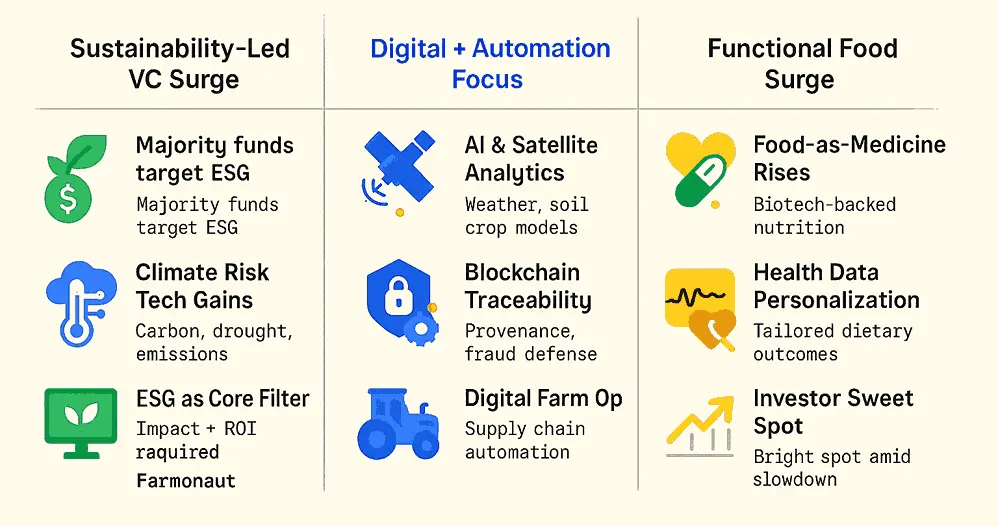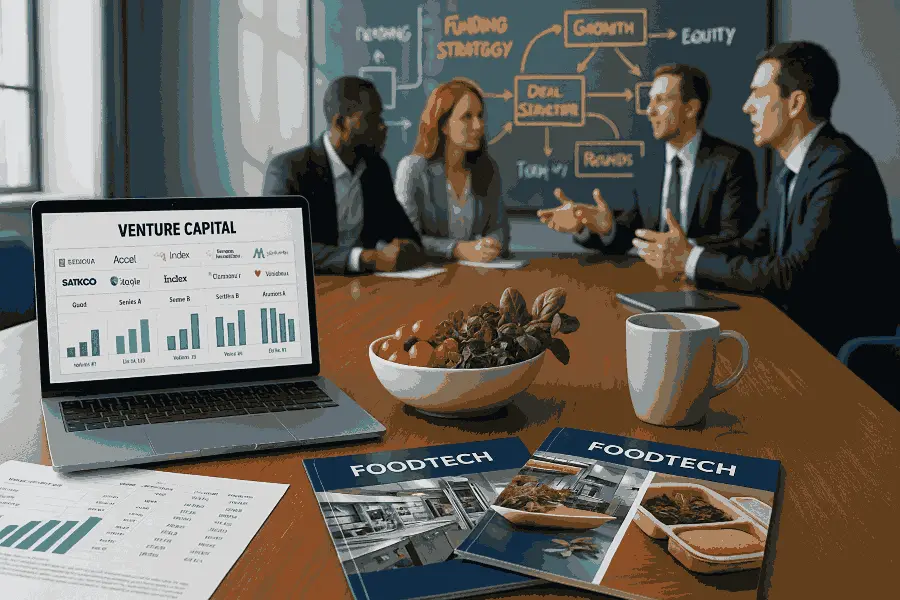The FoodTech sector has emerged as a dynamic space for innovation, attracting sustained interest from venture capital firms. Startups in this industry are transforming how food is produced, distributed, and consumed, while tackling critical challenges such as sustainability, efficiency, and supply chain resilience. In such a competitive landscape, securing funding demands a clear and strategic approach.
Recent projections highlight the scale of the opportunity. In 2024, global food services technology was valued at $210.9 billion, with forecasters expecting 8.2% annual growth through 2034. This growth trajectory explains why both investors and founders are prioritizing FoodTech as a core focus area.
Your overview is strengthened by the comprehensive framework in how to secure funding for agritech startups, which outlines clear methods for exploring financial opportunities within the FoodTech space. This guide serves as a valuable companion resource for entrepreneurs navigating the complexities of venture capital funding.
In this article, we’ll examine the key trends shaping FoodTech investments, highlight effective funding strategies, and provide actionable insights to help startups compete and thrive.
Foodtech Venture Capital Firms
In 2025, FoodTech startups are facing a tighter VC market—even as sustainability and digitalization trends keep the sector firmly on investors’ radar. Founders can no longer rely on broad, unfocused outreach; identifying the right FoodTech venture capital firms and meeting their specific expectations has become essential.
Global investments in FoodTech contracted by 59% in 2023, with funding falling from $22.5 billion in 2022 to $9.2 billion. As outlined in the Global Funding Contraction, this downturn reflects broader macroeconomic pressures and a more cautious investment climate, rather than a loss of interest in the sector itself.
In this context, founders need to be far more intentional about who they approach and how they position their FoodTech narrative.
Leveraging Investor Platforms for Targeted Outreach
Building on this funding landscape, founders can streamline investor outreach by using specialized investor platforms. These tools allow startups to filter VCs by sector focus, stage, and geography, improving the quality of each match. Smarter targeting saves time, reduces dead-end conversations, and increases the chances of connecting with investors who are genuinely aligned with FoodTech innovation. Integrating platform-driven research into your fundraising strategy helps you navigate a crowded market and secure capital from the most relevant firms.
Key Venture Capital Trends Reshaping FoodTech

a) The Rise of Sustainability-Driven Investing
“Over 60% of agriculture VC funds targets sustainability-focused and tech-driven startups, reshaping food production.”
Of the more than $1 billion invested in Q1 2025, the bulk is flowing toward sustainability-centric themes—a trend that shows no sign of reversal. Climate-smart agriculture and regenerative farming platforms are now investment imperatives. Technologies for climate risk mitigation also attract strong interest.
Startups focused on:
- Soil health monitoring, carbon tracking, drought-resilient crops, and emissions reduction are attracting significant VC dollars.
- Platforms like Farmonaut’s Carbon Footprinting provide real-time compliance and carbon monitoring, a must-have for both sustainable operations and green-minded capital partners.
Investors are increasingly screening for ESG (Environmental, Social, and Governance) metrics, with solutions that blend financial returns with measurable environmental outcomes being the new gold standard.
b) Integration of Digital and Automation Technologies
The sector is seeing high demand for digital agriculture and supply chain solutions that accelerate efficiency, transparency, and cost controls. Areas drawing VC attention include:
- Satellite data platforms
- Blockchain-based traceability
- AI-driven weather, soil, and crop analytics
- Digital farm management and logistics automation
Blockchain is transforming agri-supply chains by enabling tamper-proof traceability, authenticity, and transparency—a response both to regulatory pressure and consumer demand for ethical provenance.
c) Functional Foods and Food-as-Medicine
While the overall sector faces slowdowns, functional foods and food-as-medicine startups are outperforming. These ventures leverage advanced ingredients, personalization, and health monitoring (often underpinned by biotechnology and digital diagnostics) to deliver tailored health outcomes.
VCs identify this segment as a near-term bright spot for scaling and differentiated consumer value, even in a period of broad market contraction.
Investment Hotspots: Six FoodTech Megatrends
Across more than 30 individual sub-trends, analysts have distilled the following six megatrends that dominate VC attention in 2025:
Independent research clarifies the field’s complexity. In 2025, industry analysts identified 31 trends shaping the FoodTech future. This comprehensive breakdown gives founders clear signals for where innovation and capital align.
- Resilient Farm
- Sustainable Ingredients
- Food as Medicine
Investable opportunities lie not just in technology, but in platforms that enable operational resilience, catering to food security, climate risks, and evolving consumer/retail expectations.
The Evolution of FoodTech VC: From High-Velocity to High-Quality
FoodTech venture capital has shifted from “grow at all costs” to a far more selective, quality-focused model. Investors are still backing bold ideas, but only where traction, unit economics, and execution are clearly visible.
- Fewer, larger rounds
As of 2025, VCs are consolidating capital into fewer, higher-quality bets. Big, late-stage rounds are still very much on the table for ventures with real traction, while seed and early-stage funding has visibly tightened. - Focus on proven models
Investors are gravitating toward startups that demonstrate market validation, operational depth, and a clear (or at least credible) path to profitability. Unproven concepts, even with strong storytelling, are facing longer diligence cycles, tougher terms, and slower decision-making.
M&A and strategic exit activity
Falling valuations have primed 2025 for a rebound in mergers and acquisitions. Corporates are acquiring innovative startups to accelerate digital, sustainability, and supply chain agendas at more attractive entry prices. To put this in context, the top ten food companies spend around $22 billion annually on M&A, but only $4–5 billion on R&D—a clear signal that acquisition remains a preferred path to innovation and digital leadership.
If you’re evaluating non-dilutive funding methods alongside equity, debt financing agritech is a must-read. It explores credit-based and alternative financing structures tailored for AgriTech and FoodTech scale-ups, offering a balanced view of options beyond traditional VC rounds.
Challenges Facing FoodTech Startups and How VCs Are Responding
a) Market Volatility and Capital Discipline
Investor caution has become the norm, driven by global economic uncertainty, supply chain vulnerabilities, and sharp tech valuation resets. The steep drop in deal flow and the number of active investors since the 2021 peak underlines a clear shift from “growth at all costs” to a premium on unit economics, scalability, and proven demand.
At the same time, the long-term challenge is only growing. By 2050, the global population will approach 10 billion, requiring up to 60% more food than today. Pressure on FoodTech to deliver scalable, system-level impact continues to rise, even as capital becomes more selective.
b) Regulatory and Adoption Hurdles
FoodTech startups now operate in an increasingly complex regulatory environment, especially in segments such as alternative proteins, gene editing, and digital health. Teams with robust compliance strategies, clear roadmaps for global market fit, and partnerships with established industry players have a distinct edge.
Regulators, corporates, and VCs are aligning more closely, favoring ventures that can demonstrate safety, traceability, and responsible innovation from the start.
c) Unique Scaling Barriers
Scaling FoodTech is rarely “just software.” It often requires bridging the digital–physical divide: manufacturing, logistics, distribution, and cold chain infrastructure all add complexity and capital intensity that pure software investors may underestimate. Founders who can clearly articulate pragmatic, staged scaling plans, what to build, partner, or outsource, are more likely to secure long-term capital.
For startups preparing to scale, series a funding agritech offers an in-depth analysis of growth capital strategies. It is particularly useful for founders navigating Series A and B rounds, clarifying how to secure the capital required for expansion.
Your overview is further strengthened by the comprehensive framework in how to secure funding for agritech startups, which complements this section by outlining structured ways to explore and stack funding options across Agri/FoodTech.
Your overview is broadened by the comprehensive framework in how to secure funding for agritech startups, which outlines clear methods for exploring financial opportunities within the FoodTech space. This guide serves as a valuable resource for entrepreneurs aiming to navigate the complexities of venture capital funding.
Strategic Priorities for FoodTech VCs
1. Prioritizing Climate-Smart and ESG Solutions
Quantifying these opportunities, FoodTech now counts 62 unicorns, with $7.3 billion invested globally in H1 2024. This highlights both the ecosystem’s maturity and the scale of VC interest.
As over 60% of agriculture VC funds now explicitly pursue sustainability-driven deals, VCs are openly requiring:
- Clear climate and social ROI
- Pathways to compliance with future regulatory regimes for emissions, water use, and soil health
- Digital tools that verify and validate impact in real time
2. Backing Digital Farm Management and Data Integration
- VCs prefer platforms that aggregate and leverage data across the farm-to-fork value chain.
- Solutions integrating APIs for weather, environmental, and supply chain data are especially attractive given their scalability.
3. Supporting Advanced Biotechnologies
Biotechnology—from AI-powered crop science to biological alternatives to pesticides—continues to see strong support. Investors seek teams who can combine defensible IP with accessible, scalable tech platforms. The ability to deliver both economic (yield, margin) and environmental (carbon, chemical use) value is essential.
4. Encouraging Operational Efficiency and Automation
Operational savings, especially through robotics, process automation, and vertical SaaS—are key. These technologies minimize labor constraints and improve logistics for food production, processing, and delivery.
For startups considering alternative funding avenues, corporate partnership funding foodtech offers a detailed look at how strategic collaborations with large corporations can drive growth. This article explains how such alliances can open doors to resources, expertise, and market access.
How Founders Should Approach FoodTech VCs
To navigate the new, disciplined FoodTech VC landscape, founders must:
- Research current FoodTech VC priorities, including sustainability, scalability, and regulatory compliance, to shape your pitch narrative.
- Gather and present quantitative data demonstrating your solution’s impact on market inefficiencies and sustainability goals.
- Highlight traction through pilot results, partnerships, or early revenues to validate market demand and operational capability.
- Map out clear regulatory pathways and compliance milestones relevant to your technology and target markets.
- Tailor each pitch deck to the specific interests and expertise of the targeted investor or VC firm.
M&A, Corporate Partnerships, and the Future
Major food, agribusiness, and retail corporations are redoubling their efforts to partner with or acquire disruptive FoodTechs to future-proof their core business. This creates fresh exit pathways and the opportunity for VC-backed startups to scale via strategic collaboration.
A likely outcome for many FoodTechs is not a unicorn IPO, but rather targeted M&A, joint ventures, or integration into digital supply chain platforms. Startups that design for compatibility, interoperable APIs, and compliance are better placed for these outcomes.
Look at blended finance for agri/foodtech to combine grants, concessional loans, and commercial capital for de-risked rollouts.
Maximizing Value from VC and Corporate Partnerships
- Identify sector-specialist VCs aligned with your startup’s stage, technology focus, and geographic market for tailored support.
- Engage corporate venture programs to access pilot opportunities, collaborative R&D, and strategic market pathways.
- Structure partnership proposals to highlight compatibility, interoperability, and compliance with industry standards and regulations.
- Leverage VC and corporate networks to accelerate product validation, distribution, and scaling within established supply chains.
- Maintain transparent communication and clear milestones to build trust and maximize long-term partnership value.
Conclusion
The contraction in global FoodTech VC funding underscores the importance of strategic investor engagement for startups aiming to secure capital. Founders can benefit significantly from detailed investor lists and insights into market trends, ensuring their pitches align with current priorities. A data-driven approach, paired with a compelling narrative, remains essential for standing out in a competitive venture capital environment.
If you're ready to elevate your startup's funding journey, we invite you to explore our Fundraising Assistance service to help secure the capital you need.
Key Takeaways
- Global FoodTech VC funding has seen a significant contraction, dropping by 59% in 2023.
- VC firms are increasingly focusing on profitability and mature business models.
- Detailed investor lists and actionable trends offer crucial insights for founders.
- Emerging trends, including AI-driven investments and a flight to maturity, signal shifting market priorities.
- Utilize comprehensive resources and advanced platforms to effectively address funding challenges.
Frequently asked Questions
What are the main FoodTech megatrends attracting VC funding?
Key megatrends driving FoodTech VC in 2025 include climate-smart agriculture, sustainable ingredients, food-as-medicine, and AI-driven supply chains.






